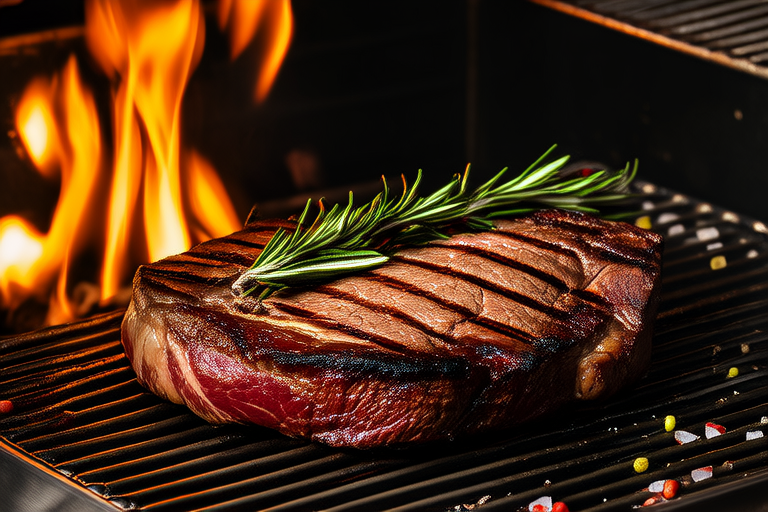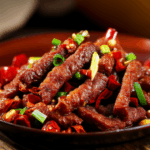Flame-Kissed Flavors: Grilling the Best Cuts of Meat
Introduction:
Welcome to the world of grilling! Whether you’re a seasoned chef or a beginner, mastering the art of grilling can elevate your culinary skills to new heights. This article will guide you through the process of selecting and preparing the best cuts of meat for grilling, ensuring that each bite is packed with flavor and juiciness. From choosing the right type of grill to understanding the nuances of different meats, we’ll cover everything you need to know to become a pro at grilling.
Selecting the Right Grill
The first step in achieving perfect grilled meat is choosing the right grill. There are several types of grills available, each offering unique advantages:
- Charcoal Grills: These provide a traditional smoky flavor and require more effort to control temperature but offer unmatched flavor.
- Gas Grills: Gas grills are convenient and easy to use, allowing for precise temperature control. They are ideal for beginners and those who prefer quick cooking.
- Wood Pellet Grills: Wood pellet grills combine the convenience of gas grills with the smoky flavor of charcoal grills. They are highly versatile and can be used for smoking as well.
Regardless of the type of grill you choose, ensure it is clean and properly maintained. A clean grill prevents food from sticking and ensures even heat distribution.
Choosing the Best Cuts of Meat
The key to great grilled meat lies in selecting the right cut. Different cuts of meat have varying levels of marbling (intramuscular fat), which affects their tenderness and flavor. Here are some of the best cuts for grilling:
Steaks
New York Strip: This cut is known for its balance of tenderness and flavor. It has less marbling than ribeye but still offers a rich, beefy taste. For the best results, season generously with salt and pepper and cook over high heat for a few minutes on each side.
Ribeye: Ribeye is one of the most popular steak cuts due to its high marbling. The intramuscular fat renders during cooking, making the meat incredibly juicy and flavorful. To enhance the flavor, consider marinating the steak in olive oil, garlic, and herbs before grilling.
T-bone: T-bone steaks consist of two cuts – the strip loin and the tenderloin. This makes them a great option for those who enjoy both the robust flavor of the strip and the tenderness of the filet. Grill over medium-high heat for about 4-5 minutes per side for a medium-rare finish.
Pork
Porterhouse: Similar to the T-bone, the porterhouse includes a larger portion of tenderloin and is typically found in larger cuts of pork. It’s an excellent choice for those who prefer a leaner, yet tender, cut of pork. Season with a blend of spices like paprika, garlic powder, and black pepper before grilling.
Spare Ribs: Spare ribs are a classic BBQ favorite. They are relatively inexpensive and have a good amount of meat. To achieve fall-off-the-bone tenderness, it’s best to cook them slowly over indirect heat for about 2-3 hours, then finish them on direct heat for a caramelized crust.
Country-Style Ribs: Country-style ribs are a leaner cut with more bone than meat. They are perfect for grilling since they can withstand higher heat without drying out. Marinate them in a mixture of soy sauce, honey, and ginger for added flavor.
Lamb
Lamb Chops: Lamb chops are a great option for grilling due to their natural fattiness, which helps keep them moist. Look for chops with a good layer of fat around the edges. Season simply with salt and pepper and grill over high heat for about 2-3 minutes per side for a seared exterior and juicy interior.
Lamb Loin: Lamb loin is similar to beef tenderloin and is known for its tenderness. It pairs well with bold flavors like rosemary, garlic, and lemon. Grill over medium-high heat for about 8-10 minutes total, depending on thickness.
Preparing the Meat
Once you’ve selected your meat, proper preparation is crucial for optimal flavor and texture. Follow these steps to ensure your grilled meat is restaurant-quality:
Marinating
Marinating can enhance the flavor and tenderness of the meat. However, it’s important to note that marinating times vary depending on the cut and size of the meat. As a general rule, allow 2-4 hours for smaller cuts and up to 24 hours for larger cuts. Some effective marinade ingredients include:
- Vinegar or citrus juice (lemon, lime, or orange)
- Olive oil
- Garlic
- Herbs and spices (rosemary, thyme, cumin, etc.)
- Soy sauce or Worcestershire sauce
Avoid using too much sugar in marinades, as it can cause the meat to burn easily when exposed to high heat.
Seasoning
Seasoning is essential for bringing out the natural flavors of the meat. Salt and pepper are staples, but you can also experiment with other seasonings like smoked paprika, chili powder, or a dry rub. Apply seasoning evenly to all sides of the meat, allowing it to sit for at least 15 minutes before grilling to allow the flavors to penetrate.
Grilling Techniques
Grilling techniques play a significant role in determining the final outcome of your meal. Here are some tips for achieving perfectly grilled meat:
Direct vs. Indirect Heat
Direct Heat: Direct heat grilling involves placing the meat directly over the heat source. This method is ideal for thinner cuts of meat and provides a quick, seared exterior while keeping the inside juicy. Use this technique for steaks, burgers, and chicken breasts.
Indirect Heat: Indirect heat grilling involves cooking the meat away from the direct heat source. This method is better suited for thicker cuts of meat, such as roasts or whole chickens, as it allows for slower, more even cooking. You can create an indirect heat zone by closing the lid and adjusting the vents.
Turning the Meat
When grilling, it’s important to avoid turning the meat too frequently. Frequent turning can lead to uneven cooking and result in tough, dry meat. Instead, let the meat form a nice sear on one side before flipping. Once flipped, avoid pressing down on the meat, as this can squeeze out juices and reduce flavor.
Resting the Meat
After removing the meat from the grill, allow it to rest for a few minutes before slicing. Resting time varies based on the cut and size of the meat. Larger cuts may require up to 10-15 minutes, while smaller cuts may only need 3-5 minutes. During this time, the juices redistribute throughout the meat, ensuring a moist and flavorful eating experience.
Serving Suggestions
Grilled meat pairs beautifully with a variety of accompaniments. Here are some ideas to complement your grilled masterpieces:
- Vegetables: Grilled vegetables like bell peppers, zucchini, and onions add color and nutrition to your plate. Toss them in olive oil, salt, and pepper before grilling.
- Sauces: Create a simple sauce using ingredients like balsamic vinegar, Dijon mustard, and honey. Drizzle over the meat for added flavor.
- Side Dishes: Serve with a fresh salad, mashed potatoes, or roasted potatoes for a complete meal.
Conclusion
Grilling the best cuts of meat is an art that requires attention to detail and practice. By selecting the right grill, choosing the appropriate cuts of meat, and employing proper preparation and cooking techniques, you can create mouthwatering, flame-kissed dishes that will impress your guests. Happy grilling!


